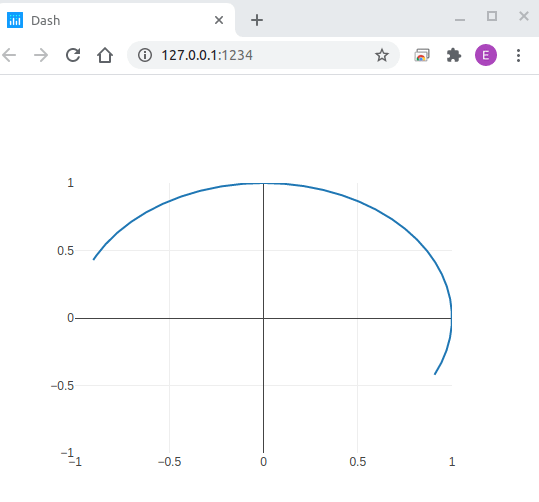Updating traces of a Graph component without generating a new graph object can be achieved via the extendData property. Here is a small example that appends data each second,
import dash
import dash_html_components as html
import dash_core_components as dcc
import numpy as np
from dash.dependencies import Input, Output
# Example data (a circle).
resolution = 20
t = np.linspace(0, np.pi * 2, resolution)
x, y = np.cos(t), np.sin(t)
# Example app.
figure = dict(data=[{'x': [], 'y': []}], layout=dict(xaxis=dict(range=[-1, 1]), yaxis=dict(range=[-1, 1])))
app = dash.Dash(__name__, update_title=None) # remove "Updating..." from title
app.layout = html.Div([dcc.Graph(id='graph', figure=figure), dcc.Interval(id="interval")])
@app.callback(Output('graph', 'extendData'), [Input('interval', 'n_intervals')])
def update_data(n_intervals):
index = n_intervals % resolution
# tuple is (dict of new data, target trace index, number of points to keep)
return dict(x=[[x[index]]], y=[[y[index]]]), [0], 10
if __name__ == '__main__':
app.run_server()
Depending of the network connection between client and server (at each update, a request is exchanged between client and server), this approach works up to a refresh rate of around 1s.
If you need a higher refresh rate, i would suggest doing the graph update using a client side callback. Adopting the previous example, the code would be along the lines of
import dash
import dash_html_components as html
import dash_core_components as dcc
import numpy as np
from dash.dependencies import Input, Output, State
# Example data (a circle).
resolution = 1000
t = np.linspace(0, np.pi * 2, resolution)
x, y = np.cos(t), np.sin(t)
# Example app.
figure = dict(data=[{'x': [], 'y': []}], layout=dict(xaxis=dict(range=[-1, 1]), yaxis=dict(range=[-1, 1])))
app = dash.Dash(__name__, update_title=None) # remove "Updating..." from title
app.layout = html.Div([
dcc.Graph(id='graph', figure=dict(figure)), dcc.Interval(id="interval", interval=25),
dcc.Store(id='offset', data=0), dcc.Store(id='store', data=dict(x=x, y=y, resolution=resolution)),
])
app.clientside_callback(
"""
function (n_intervals, data, offset) {
offset = offset % data.x.length;
const end = Math.min((offset + 10), data.x.length);
return [[{x: [data.x.slice(offset, end)], y: [data.y.slice(offset, end)]}, [0], 500], end]
}
""",
[Output('graph', 'extendData'), Output('offset', 'data')],
[Input('interval', 'n_intervals')], [State('store', 'data'), State('offset', 'data')]
)
if __name__ == '__main__':
app.run_server()
Client side updates should be fast enough to achieve a smooth update. The gif below shows the above example running with 25 ms refresh rate,

Keep in mind that a client side update is only possible if the data is already present client side, i.e. another mechanism is needed to fetch the data from the server. A possible data flow could be
- Use a slow
Interval component (e.g. 2 s) to trigger a (normal) callback that fetches a chunk of data from the source and places it in a Store component
- Use a fast
Interval component (e.g. 25 ms) to trigger a client side callback that streams data from the Store component to the Graph component
